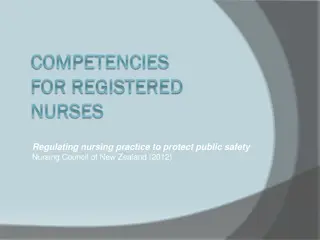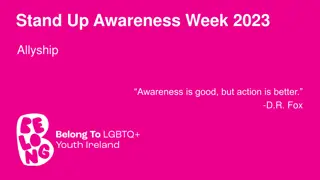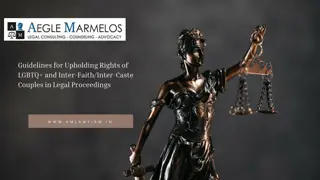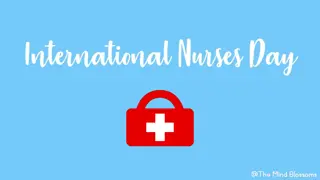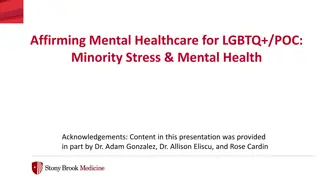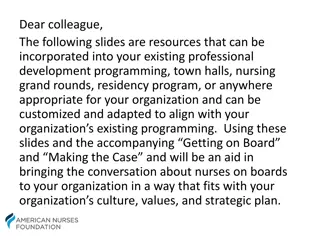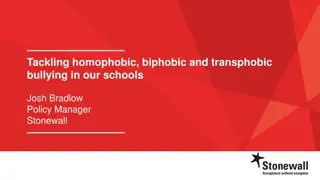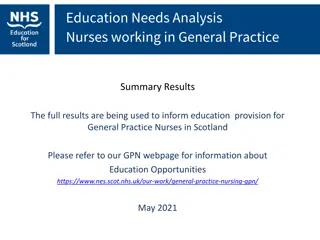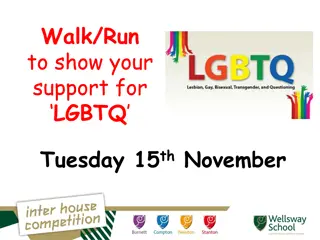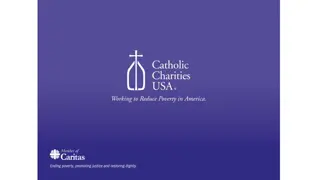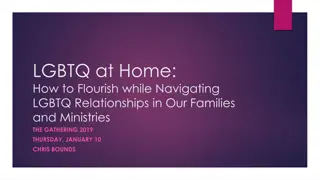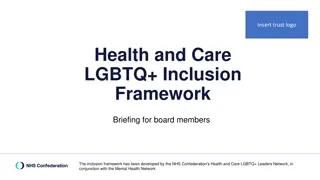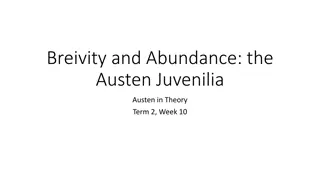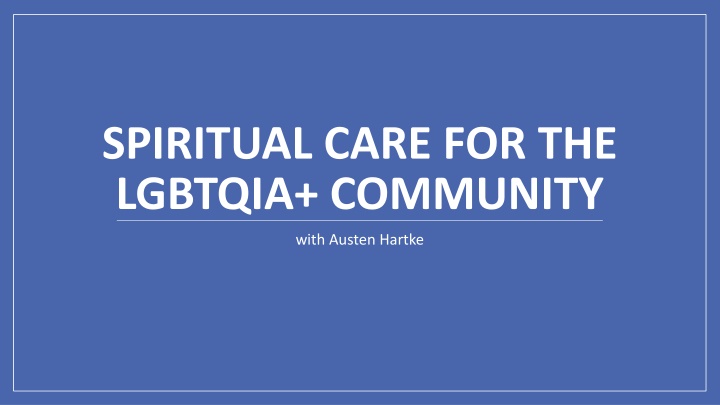
Spiritual Care for LGBTQIA+ Community
Explore the challenges faced by the LGBTQIA+ community, including rejection, minority stress, and religious trauma. Learn about the impact of these factors on mental health and well-being, as well as ways to provide support and care. Discover insights from research and personal experiences to enhance understanding and promote inclusivity.
Uploaded on | 1 Views
Download Presentation

Please find below an Image/Link to download the presentation.
The content on the website is provided AS IS for your information and personal use only. It may not be sold, licensed, or shared on other websites without obtaining consent from the author. If you encounter any issues during the download, it is possible that the publisher has removed the file from their server.
You are allowed to download the files provided on this website for personal or commercial use, subject to the condition that they are used lawfully. All files are the property of their respective owners.
The content on the website is provided AS IS for your information and personal use only. It may not be sold, licensed, or shared on other websites without obtaining consent from the author.
E N D
Presentation Transcript
SPIRITUAL CARE FOR THE LGBTQIA+ COMMUNITY with Austen Hartke
UNDERSTANDING BACKGROUND FACTORS
Rejection and suicidality According to the 2011 National Transgender Discrimination Survey, conducted by the National LGBTQ Task Force, 18% to 28% of lesbian, gay, and bisexual people attempt suicide, and 41% of transgender people attempt suicide. Compare this to the US national average of 4.6% LGBTQ+ people who experience family rejection are twice as likely to attempt suicide, and religion is cited as one of the largest factors in family rejection* *Ryan, C., Russell, S. T., Huebner, D., Diaz, R., & Sanchez, J. (2010). Family Acceptance in Adolescence and the Health of LGBT Young Adults. Journal of Child and Adolescent Psychiatric Nursing, 23(4), 205-213.
Minority stress Minority stress: The friction that occurs between a person who holds a marginalized identity, and the hostile surrounding environment they live in. LGBTQ+ people often live with a continuous expectation of rejection, and an underlying current of fear because of the threat of physical or emotional violence. This constant stress can lead to depression, anxiety, substance abuse disorders, and suicidal thoughts and actions. When an LGBTQ+ person also holds another marginalized identity, the stress they experience is compounded. A study of American Indian and Alaskan Native adolescent men in Minnesota found that 47.3% of gay youth had considered suicide, compared with 23.6% of their straight peers.* * Barney, D. D. (2003). Health risk-factors for gay American Indian and Alaska Native adolescent males. Journal of Homosexuality 46 (1), 137-157. For more on minority stress, see: Meyer, Ilan H. "Prejudice, Social Stress, and Mental Health in Lesbian, Gay, and Bisexual Populations: Conceptual Issues and Research Evidence." Psychological Bulletin 129.5 (2003): 674 69.
Minority stress Things that can cause/exacerbate minority stress can include: a lack of social structure or visible modeling that includes people like you lack of access to institutions and resources because of your identity experiencing verbal, physical, or mental abuse because of your differences being subjected to stereotypes internalizing other people's negative views a lack of hope for these conditions to change in the future For more, see: Kelleher, Cathy. "Minority stress and health: Implications for lesbian, gay, bisexual, transgender, and questioning (LGBTQ) young people." Counseling Psychology Quarterly 22, no. 4 (December 2009): 373-379, 376.
Religious trauma and moral injury Religious Trauma Pervasive psychological damage resulting from religious messages, beliefs, and experiences. Unlike many forms of trauma that occur through acute incidents, religious trauma generally accrues gradually through long-term exposure to messages that undermine mental health Religious trauma shares many symptoms with posttraumatic stress disorder (PTSD), including avoidance of stimuli that are reminiscent of the trauma and intense distress when exposed to such stimuli. - Stone, Alyson M. Thou Shalt Not: Treating Religious Trauma and Spiritual Harm With Combined Therapy. Group, vol. 37, no. 4, 2013, pp. 323 37. Moral Injury Moral injury originates at an individual level when a person perpetuates, fails to prevent or bears witness to a serious act that transgresses deeply held moral beliefs and expectations which leads to inner conflict because the experience is at odds with their personal core ethical and moral beliefs. - Carey, Lindsay B, Timothy J Hodgson, Lillian Krikheli, Rachel Y Soh, Annie-Rose Armour, Taranjeet K Singh, and Cassandra G Impiombato. 2016. Moral Injury, Spiritual Care and the Role of Chaplains: An Exploratory Scoping Review of Literature and Resources. Journal of Religion and Health 55 (4): 1218 45.
A dangerous combination Three themes were identified in the stories of survivors of conversion practices and mental health practitioners supporting their recovery: 1) harm from spiritual practices; 2) harm from impairment of relationship with spiritual community; and 3) harm to spiritual self-concept, meaning and experience. When supporting survivors, Morrow (2003)* recommends helping professionals to: evaluate the extent of religious trauma; honour losses engendered by religious oppression; address the impact of religion as a tool for social injustice; and develop a list of religious and spiritual resources to share with clients. She stresses the importance of honouring client self- determination with regard to religious belief, rather than assuming or imposing personal religious or secular attitudes [A]ttending to survivors sense of agency in their experience of religious trauma and moral injury may usefully point to their agency in healing. - Jones, Timothy W., et al. Religious Trauma and Moral Injury from LGBTQA+ Conversion Practices. Social Science & Medicine, vol. 305, July 2022, 115040. *Morrow, Deana F. Cast into the Wilderness: The Impact of Institutionalized Religion on Lesbians. Journal of Lesbian Studies, vol. 7, no. 4, Dec. 2003, 109 23.
Is religion always a protective factor? [For sexual minority youth] the predicted probability of engaging in NSSI (non-suicidal self injury) is .49 for Christians who receive little to no guidance, .66 for Christians who receive some guidance, .80 for Christians who receive quite a bit of guidance, and .89 for Christians who receive a great deal of guidance from their religious beliefs. Increases in religiosity among sexual minority youth who identify as Christian are associated with greater risk of NSSI. - Longo, Joseph, et al. Religion and Religiosity: Protective or Harmful Factors for Sexual Minority Youth? Mental Health, Religion & Culture, vol. 16, no. 3, 2013, pp. 273 90. [T]hose who experienced a religious upbringing and are currently experiencing religious conflict were most at risk of considering suicide. Further, a religious upbringing in itself does not provide protection from suicidal ideation when compared to a non- religious upbringing. Thus, it appears that a religious upbringing that includes unresolved religious and LGBT identity conflict puts an individual more at risk of suicidal thoughts. - Gibbs, Jeremy J. Religious Conflict, Sexual Identity, and Suicidal Behaviors among LGBT Young Adults. Archives of Suicide Research, vol. 19, no. 4, 12 Mar. 2015, 472 488.
Can religion be a protective factor for LGBTQIA people? [T]he harmful effects of discrimination among sexual minority youth affiliated with denominations that endorsed same-sex marriage were significantly less than those among peers who affiliated with denominations opposing same-sex marriage or who identified as secular [Religious affiliation] could be either a risk or a protective factor, depending on the religious group s stance toward same-sex sexuality. - Gattis, Maurice N., et al. Discrimination and Depressive Symptoms among Sexual Minority Youth: Is Gay-Affirming Religious Affiliation a Protective Factor? Archives of Sexual Behavior, vol. 43, no. 8, 14 Aug. 2014, 1589 1599. [O]lder gender and sexual minority adults who are more out to their religious communities are less likely to be depressed and lonely The links between outness and other areas of religious involvement still have yet to be determined, however, previous research does suggest that being out in an identity affirming religious environment could be valuable for older LGBTQ adults to promote healthy aging, as seen in the general population of geriatric studies, which is predominantly representative of heterosexual older adults. - Escher, Catherine, et al. Relations of Religion with Depression and Loneliness in Older Sexual and Gender Minority Adults. Clinical Gerontologist, vol. 42, no. 2, 5 Sept. 2018, pp. 150 161.
The importance of nurses Nurses can carry out various interventions to reduce health inequities in LGBT people such as programmes on inclusive sex education, sexual and gender diversity, and bullying and suicide prevention. In this sense, the figure of the school nurse acquires great importance because of their potential ability to strongly influence outcomes for LGBT people Because nurses interact with all health staff, they may be in a privileged position to oversee patient experiences and to lead efforts to educate staff in the fundamentals of providing respectful care to all patients with cultural humility. On occasion, they can advocate for LGBT patients and console or support those who may have been subjected to discriminatory practices. Additionally, nurses can sometimes intervene by convincing patients who have been discriminated against to schedule another appointment with a different provider, or by directing them to patient relations managers to make complaints. - Medina-Mart nez, Jorge, et al. Health Inequities in LGBT People and Nursing Interventions to Reduce Them: A Systematic Review. International Journal of Environmental Research and Public Health, vol. 18, no. 22, 2021, 11801.
The importance of names and pronouns Transgender youth ages 15 to 21 who had their chosen name used at school, work, home, and with friends had 71% fewer symptoms of severe depression, a 34% decrease in reported thoughts of suicide and a 65% decrease in suicide attempts. Having even one context in which a chosen name could be used was associated with a 29% decrease in suicidal thoughts. - Russell, Stephen T et al. Chosen Name Use Is Linked to Reduced Depressive Symptoms, Suicidal Ideation, and Suicidal Behavior Among Transgender Youth. The Journal of Adolescent Health vol. 63,4 (2018): 503-505. Use of the correct pronouns for a transgender/nonbinary/gender-expansive individual make them more likely to seek healthcare when they require it, and use of incorrect pronouns by healthcare providers cause gender-expansive people to avoid seeking care. Kattari, Shanna K et al. Correlations between healthcare provider interactions and mental health among transgender and nonbinary adults. SSM - Population Health vol. 10 100525 Goldberg, Abbie E., et al. Health Care Experiences of Transgender Binary and Nonbinary University Students. The Counseling Psychologist, vol. 47, no. 1, 8 Mar. 2019, 001100001982756.
Respecting pronouns Pronouns can replace nouns when we refer to someone else in the third person. She loves armadillos! His shoelaces are untied! They/them/their as a singular pronoun: There's not a man I meet but doth salute me//As if I were their well-acquainted friend Shakespeare, A Comedy of Errors Had the Doctor been contented to take my dining tables as any body in their senses would have done Jane Austen, Mansfield Park New pronouns have also been invented to give us more gender-neutral options, and fill in the gaps in our language! He She They Ze Ve Fae Him Her Them Zir Ver Faer His Hers Theirs Zirs Vis Faers Himself Herself Themself Zirself Verself Faerself
Coming out/Inviting in Be aware that: Coming out is almost never a one-time thing. Coming out almost always begins with coming out to self before it s ever acknowledged to others. Some people may have no desire to invite anyone into the details of their personal relationships or experiences with gender. Coming out/inviting in with others is not a requirement. Some people may be outed without their consent, and may need specific help dealing with the personal and social aftermath. Most states do not have protections for LGBTQ people in areas of work or housing. When someone comes out/invites you in Their safety and health is the first concern. Keep confidence. If you can t support them, find someone who can.
A pastoral care checklist Examine your assumptions Care receivers may not wish to talk about their gender or orientation Care receivers may want to come out/invite in, or they may not have any desire to They may have a negative or a positive history with religion They may expect you, as a religious figure, to have negative feelings about LGBTQ+ people, and may be on the look out for signs confirming this They may not identify as LGBTQ+, and may instead identify as a person with gender dysphoria or a same-sex-attracted person Remember that the gender of the person the care receiver is in a relationship with does not necessarily tell you anything about the care receiver s orientation 1. Stay informed Keep a list of helplines, books, websites, movies, and mental health practitioners you can refer care receivers to Know the official teachings of local churches and denominations with regard to LGBTQ+ issues Keep up to date on the language used within LGBTQ+ communities Keep up to date on local and national legislation related to LGBTQ+ communities 2.
A pastoral care checklist Be self-aware Monitor underlying homophobia and/or transphobia Be clear about the limitations of the support you can offer Be prepared to assert boundaries with care receivers who may unconsciously or consciously solicit physical manifestations of care 3. Respect Respect the care receiver s understanding of their identities, and don t try to tell them what you believe that identity means Don t ask inappropriate or non-applicable questions about the care receiver s relationships, medical history, or current medical status Respect the fact that some LGBTQ+ people may struggle with a feeling of conflict between their identities and their faith, and others may not see any problem at all 4. Adapted from pgs 70-72 in Ministry Among God s Queer Folk: LGBTQ Pastoral Care, 2nded. by Bernard Schlager and David Kundtz
Concerns for specific communities Bisexual/Pansexual Erasure Being disbelieved Being hypersexualized Two Spirit Overlapping discrimination Displacement and disconnection from history and community Appropriation Transgender Medical gatekeeping Visibility re: physical violence Incarceration and legal documentation Asexual Medicalization Being disbelieved Misunderstandings about the difference between sexuality and affection Intersex Nonconsensual surgery Lack of visibility Legal documentation
Spiritual/emotional concerns Coming out/Inviting in Fear Rejection from family members Anger Rejection from (faith) community Loss Healing from violence and abuse Self-acceptance Eschatological concerns (heaven/hell/afterlife) Finding/creating new community Engaging with rituals Isolation Engaging with sacred writings Shame
Practice scenarios - #1 You re a nurse employed in a large faith community. Sonja (she/her), a 14-year-old member of your congregation with diabetes, has come to your office to test her blood sugar during the worship/prayer component of a youth event. As you re assisting her, she mentions that she s not having fun at the event, and when you ask her why, she expresses discomfort with the worship/prayer space. You ask how that space makes her feel, and she says It just makes me think about how some people are going to hell. Maybe I am. I don t know. You ve seen Sonja carrying a bag that has rainbow stickers on it, but you don t know how she identifies or whether this concern is related to being LGBTQ+. What do you do? What do you avoid doing? Bonus: How would your response change if Sonja had previously disclosed that she was bisexual?
Practice scenarios - #2 You re a nurse employed in a medium-size faith community in a rural area. You ve been asked to make a home visit to Sam (he/him), a 55-year-old community member who recently had a hip replacement and hasn t been able to attend services. You know that Sam is gay, and that he joined your community about 6 months ago. As you visit, you learn that Sam had been an active member of his previous faith community for the last 15 years, but that he had left after coming out. He says, I guess they just weren t ready to hear it. I knew it was a risk, but I didn t actually think they d respond like they did. They kicked me off the council, everyone stopped talking to me except to tell me I needed to pray harder. I just couldn t stand it after a while. I guess I m still worried the same thing will happen here. What do you do? What do you avoid doing? Bonus: How might you advocate for Sam with your current community?
Practice scenarios - #3 You re a nurse hired by a faith-based organization to provide end-of-life support. Jamie (they/them) is one of your patients. Jamie is a 40-year-old nonbinary person who was diagnosed with an aggressive form of cancer that s resistant to treatment. You know from previous conversations that Jamie isn t married and doesn t have a good relationship with their family of origin. Jamie is especially worried that they will be misgendered after death, and one day they tell you I really love our funeral liturgy. There s just a lot of meaning for me in those words. Knowing that the [pastor/rabbi/imam] will be saying them for me is important, and I m worried that my family or someone else is going to try to get people to use the wrong name and pronouns in the service. What do you do? What do you avoid doing?
Keep learning! Resources on gender diversity and Christianity for trans folks, family members, and pastors: https://transmissionministry.com/resources My contact info: Website: www.austenhartke.com Email: info@austenhartke.com Facebook: www.facebook.com/AustenHartke Twitter: @AustenLionheart Youtube: www.youtube.com/AustenLionheart




